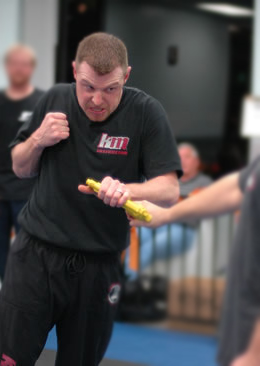In keeping with this week’s gun defense theme, here are some videos from Krav Maga Worldwide Sherman Oaks. Some techniques are the basics we have been working on, some are more advanced techniques we will be training in tomorrow’s Intermediate Gun Defense Seminar.
April 2010 Syllabus
The April 2010 syllabus is subject to change. This post will be updated throughout the month.
Questions? Post to the comments!
Guest Instructor Richard Schott – 04.05.10

Brian’s Expert Series training partner, Richard Schott, will be a guest in our Level 2 class Monday, April 5. The theme for the night will be “fighting while inebriated* or disoriented”.
Richard is a Krav Maga black belt and the chief instructor at CORE Self-Defense in El Cajon, California. He is a very dynamic teacher, so this class should be both informative and a lot of fun!
*Inebriation will be simulated. Come to class pre-drunk (with a DD) at your own peril!
The Shirt Grab & Finishing the Fight
Here’s an interesting video from Rodney King of Crazy Monkey Defense that ties into the shirt grab question that came up at the end of Tuesday night’s class:
Overall, I think the Crazy Monkey Defense stuff compliments the “fighting” portion of Krav pretty nicely. I like a lot of the concepts that I’ve seen online and even experimented with incorporating pieces into the last sparring rotation. While taking the opponent’s back as Rodney does in the video is not necessarily something encouraged in Krav Maga, the opening certainly is. Some compliance-type techniques (i.e. joint locks and pressure points) from styles like Kenpo and Modern Arnis Jujitsu, while effective in certain circumstances, require much more time to train; rely on fine motor movements that can degrade under stress; and often require both your hands, leaving you more vulnerable to subsequent attacks. Striking, however, has a less steep learning curve because it is more instinctive; relies on gross motor movements that are less affected by stress; and, if you’re hands always return to your fighting stance, offers a better degree of protection against a flailing opponent. (Keep in mind, though, that use of force issues are more likely to arise with strikes.)
This video demonstrates three key Krav Maga concepts that apply to nearly every self-defense scenario:
- The “when” concept. If you can talk your way out of a scenario like this, by all means do so. If, however, you sense the shirt grab is just a precursor to greater violence, when is now.
- See within the fight. Once you’ve made the decision to spring to action, don’t expect your opponent to stand there like a punching bag, and don’t get so tunnel-visioned with what you’re doing that you don’t register subsequent attacks (or attackers). Remember, it’s usually the one you don’t see that’ll knock you out.
- Finish the fight. Once you’ve engaged, do not stop until A) you’ve created enough space to safely escape, or B) the threat has been neutralized.
Developing Your “When”

One concept that sets Krav Maga apart from most other self-defense systems is that we consistently train from a position of disadvantage. The belief is that all techniques must work whether we are prepared or not, as most situations requiring us to defend ourselves occur suddenly and with little warning. If we only trained from a prepared position (our fighting stance), we would either be delayed to action or—much worse—freeze when caught off guard.
Part of our training involves practicing both offensive and defensive techniques from what we call passive or neutral position. Beyond developing lighting-fast reaction, not much forethought must go into defensive techniques; the decision to act has been made for us by the attacker. Launching a preemptive assault, however, is a very different situation. We must consider the how?, the when?, and the what then? (the immediate and longer-term consequences) of such an action.


